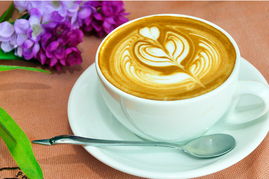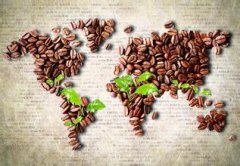The historical and cultural origin and making of latte
Latte is a classic blend of Italian espresso and milk. Italians also like lattes as breakfast drinks. In the Italian kitchen in the morning, coffee and milk are usually brewed on the sunlit stove. Italians who drink lattes like milk rather than espresso, and only espresso can bring unforgettable taste to ordinary milk.

Italian lattes (CaffeLatte) require a small cup of Espresso and a cup of milk (150,200ml). Lattes contain more milk and less coffee, which is very different from Cappuccino. The latte is as simple as pouring nearly boiling milk into a freshly made espresso. In fact, there is no fixed rule on how much milk is added, and it can be freely mixed according to individual taste.
If you add some frothy cold milk to the hot milk, it becomes an American latte. Starbucks American lattes are made in this way, with espresso at the bottom, milk heated to 65 to 75 ℃ in the middle, and cold milk foam of no more than half a centimeter.
If you do not put hot milk, but directly decorate two tablespoons of milk foam on the Italian espresso, it becomes the Machi Hadot coffee called EspressoMacchiato by the Italians. Coffee é AuLait can be regarded as an European latte, which is quite different from American latte and F latte. Ole Coffee is also very simple: pour a cup of espresso and a large cup of hot milk into a large cup at the same time, and finally put two tablespoons of whipped cream on the surface of the liquid. The biggest difference between Oulei coffee and American latte and Italian latte is that it requires milk and espresso to be injected into the cup together. Milk and coffee meet at the first time, resulting in a feeling of leisure and freedom. The French are the most enthusiastic proponents of Ole Coffee. You will see the round Orei Cup on the breakfast table in France, which is the source of their good mood for the day. Interestingly, compared with all the coffee cups, the cup used by the French to hold Ole coffee is probably the largest.
Latte is the most familiar Italian coffee item in China. It is fancy coffee with equal proportion or even more milk in the thick and full-bodied ESPRESSO. With the warm seasoning of milk, the original sweet and bitter coffee becomes smooth, sweet and rich, even those who are not used to drinking coffee can not compete with the fragrant taste of latte. Like cappuccino, lattes are suitable for drinking in the morning because they contain a lot of milk. Italians also like to use it to warm their stomach and go with breakfast. Many people do not understand the relationship between lattes and Olei. In fact, lattes are Italian New year milk coffee, steaming milk in the way of machine steam, while Oulei is French coffee. They boil the milk over fire, and the taste is warm and smooth. Practice: use utensils and materials. The amount of deep-roasted coffee beans is moderate. The right amount of milk (the proportion of fresh milk in coffee is 1:1) 1. Soak the cup (warm cup) in hot water to raise the temperature, then pour out the excess water and use 2. 2. Grind the deep-roasted coffee beans, pour the coffee powder into the filler, flatten the coffee powder with a press stick, then buckle the filler to the espresso machine extraction port, and extract ESPRESSO (the proportion of fresh coffee milk is 1:1). 3. Take the right amount of milk and put it under the steam nozzle of the espresso machine to steam it into hot milk. 4. Pour the steamed milk into the cup. 5. Shake the cup up and down to raise the foam by 6. 5%. Finally, pour the ESPRESSO into the cup slowly.
Important Notice :
前街咖啡 FrontStreet Coffee has moved to new addredd:
FrontStreet Coffee Address: 315,Donghua East Road,GuangZhou
Tel:020 38364473
- Prev

The historical origin and development of cappuccino coffee
At the beginning of the 20th century, when the Italian Azibucha invented the steam pressure coffee machine, he also developed cappuccino coffee. Cappuccino is an Italian coffee mixed with the same amount of Italian espresso and steamed milk. At this time, the color of coffee is like a cappuccino monk covering a dark brown coat with a headscarf, hence the name caffeine. Tradition
- Next

Coffee culture Coffee spread track in the world
Coffee was introduced into Europe Islam prohibited drinking alcohol, but also from the side to promote people to drink a lot of coffee, in the 16th century, coffee in the name of Arabic wine attracted the attention of European countries. However, Arab countries are very strict with the export of coffee, and even require raw beans to be boiled before they can be exported. However, with the continuous development and frequency of trade, coffee in Europe in the mid-17th century.
Related
- How did the Salvadoran coffee industry develop in Central America?
- What exactly does the golden cup extraction of coffee mean?
- The Origin of Coffee flower
- [2023 Starbucks World Earth Day] there are more meaningful things besides free Starbucks coffee!
- What kind of coffee is there in Spain? 9 Flavors of Spanish Coffee
- Aromatic African coffee| Kenya's coffee culture and historical production area
- Liberica Coffee Bean knowledge: the characteristics of Liberian Coffee beans of the three original species of Coffee beans
- The origin and formula of Spanish latte introduces the taste characteristics of Bombon coffee in Valencia, Spain.
- How to adjust the solution of over-extracted coffee
- What is the tasting period of coffee beans? What is the period of coffee and beans? How should coffee wake up and raise beans?

